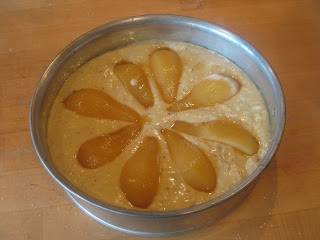I bought the halibut so that I could use up a red pepper, and some sriracha...sounds crazy, but it's the truth. The red pepper was losing its crispiness, so I roasted it, and made a spicy may to serve with the simple, pan fried halibut and capers.
It was a success, and the leftover mayo was used for sandwhiches the next day. The remaining roasted red pepper was used on a pizza. I served it with my version of salt and vinegar roasted potatoes, an inspiration I found on thecomfortofcooking.com, and some fresh asparagus.
Roughly chop:
1/2 roasted red pepper
1 clove garlic
Puree using a hand blender, adding 1 tablespoon of olive oil.
Add:
1/4 cup of mayonnaise
1 teaspoon sriracha
Puree until smooth and well combined.
Taste and adjust seasoning...salt, pepper or more sriracha if needed.
Stir in:
1 tablespoon chopped fresh basil
Set aside while you cook the fish.
Season both sides of the halibut with salt and pepper.
Heat a pan with olive oil until it is smoking hot. Add the fish and cook until it is crispy and brown on the bottom. It should be halfway cooked at this point.
Carefully turn the fish over to cook the other side.
Add:
1 tablespoon capers
Cook until the fish is done, and the capers are crispy on the outside.
Remove the fish from the pan and serve with the roasted red pepper mayo and crispy capers.
- If you do not have a freshly roasted red pepper, or a fresh red pepper to roast, use purchased roasted red pepper. They can be found in most grocery stores, and are usually in jars, which makes it easy to keep the rest for another meal.
- I used a hand blender for this small amount...I was only feeding two people. For a larger amount of sauce a blender or food processor can be used. If you choose to use a food processor, stir the mayonnaise in by hand, as it tends to split when processed.
- Any hot sauce can be used. It can also be omitted if you are a not a fan of spicy foods; the amount can also be increased.
- I had fresh basil, and used it to complement the capers. Cilantro is another choice for this sauce, as are parsley or fresh chives.
- The sauce can be stored in the refrigerator for a few days, well covered. It can be used on sandwhiches or wraps; to make chicken, egg or tuna salad; added to cooked potatoes to make a spicy potato salad.
- The sauce can be served with any fish, grilled, roasted or pan fried. It can also be served with chicken.
- The capers will crisp up on the outside, but still be soft on the inside. They add some texture and tang to cut through the richness of the mayonnaise. If you want the capers to be crispier, cook them for longer, adding them to the pan at the same time as the fish. You can also shallow fry them in really hot oil (a temperature of about 350F works best), and then drain them on paper towel to remove as much excess oil as possible.
- Crispy capers can be served on salads; with smoked salmon; as a garnish for a seafood pasta.
- A wedge of fresh lemon can be served with the fish...the juice will enhance the fish and also offset the richness of the sauce.
























































